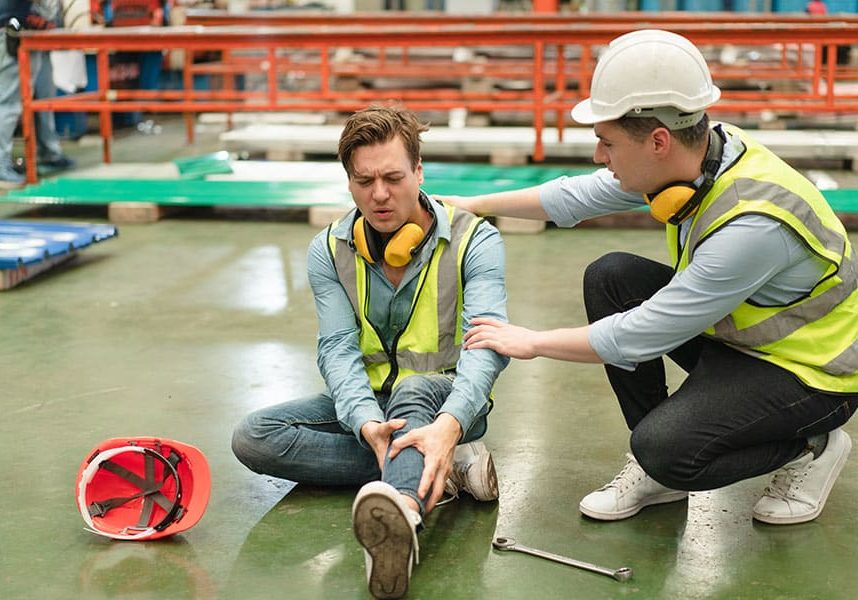“To err is human.” “Everyone makes mistakes.” “Pobody’s nerfect.” These are common phrases that we use to remember that we all mess up sometimes.
But that doesn’t mean we can excuse poor or unsafe behavior in the workplace just because it’s going to happen sooner or later. On the contrary, the very nature of humans’ collective tendency to make mistakes should make safety a workplace priority. It prevents, or at the least mitigates, the impact that errors can have on individuals and your business as a whole.
That’s where safety culture comes into play.
In this resource, we’re going to break down the concept of a safe work culture, go through some of its benefits, and lay out a safety program blueprint for improving safety culture within your own business – starting with who you hire.
What Does Safety Culture Mean?
If you were hoping for a crystal clear definition, you’re going to have to settle for the next best thing. The concept of a culture focused on safety is vague enough that it hasn’t been given a universally agreed-upon standard definition at this point.
However, there are certain themes included in most definitions of an effective safety culture, and they’re worth looking at.
First and foremost, at its core, an organization’s safety culture is about how people work together. It is also a workplace culture (i.e., a culture within an organization) where safety is a top priority. It’s the formal equivalent of a “this is the way it is done here” attitude.
Strong safety culture includes paying close attention to:
- Employee and employer attitudes and behaviors.
- Individual perceptions of the workplace.
- The integrity, values, and beliefs that each person brings to work each day.
The Australian Radiation Protection and Nuclear Safety Agency (which we can all agree is a field where safety is paramount) identifies two key items that makeup safety culture. The first is the existence of the above elements, things like integrity and the right attitudes and behaviors that lead to workplace safety.
The second is the ability to spread those elements throughout a culture, both horizontally and vertically, as well as in the present and future. To be effective, safety culture needs to be communicated to and adopted by leadership and staff alike. It also needs to take root now and continue to have a positive impact on future safety performance.
To put it another way health and safety needs to actually affect what happens in an organization. It can’t just be an idealistic mission statement with nothing to back it up. It needs to come from a deeply ingrained sense of commitment from workers to follow the rules and from employers and management to invest in them (i.e., create and follow those rules), too.
The Department of Labor reports that organizational factors have the biggest impact on safety in the workplace. This shouldn’t be surprising. When a workforce feels leadership is committed to safety compliance, creating safety management systems, report safety hazards and addressing safety concerns, they’re more inclined to follow the rules set in place. The result is better compliance and, naturally, a safer space to work.
Safety Culture Examples
To better understand what safety culture looks like, let’s consider a few examples.
Safety starts in the hiring phase. When you’re hiring a new employee, you might use an integrity test or check references (more on these and other key safety tools further down) to gauge if an employee will be a safe worker within your organization.
Another example is onboarding and ongoing training of personnel. Some fields, like healthcare, see a lot of change in procedures, processes, and personnel. Equipment is often changing, as well. Healthy safety initiatives will ensure that employees understand how to properly utilize all of these things at all times.
Yet another, more literal example of a company’s safety culture could be a worker in a warehouse wearing protective gear and following standard procedures without question. They could also improve safety by performing proper risk assessments on the job and reporting workplace hazards and incidents properly.

Why Is Culture Important in Health and Safety?
It isn’t hard to argue that safety goals are needed in the workplace. It doesn’t matter if you’re operating heavy machinery, on your feet bussing tables, or sitting in a desk chair all day. You want to have safety measures in place to ensure that certain things don’t happen.
But what about the culture part? What does it mean to have a culture based on safety?
When you have an effective security culture, it means your organization operates at safe levels, not just in a particular area but throughout all of its activities. By taking safety seriously from top management to employee and in every department, it ensures that all parties involved in your operation are doing their part at all times to keep your company a safe place to work. It doesn’t have to cost supervisors and managers considerable resources to simply make it a priority.
What Are the Downsides to Not Having a Strong Safety Culture?
Safety policies and individual and group values aren’t organic. In fact, when you fail to consider key elements in your workforce, like a lack of integrity or previous poor behavior, you can begin to introduce trouble-making or ill-equipped workers into your workplace. These problem hires can undermine safety and lead to a poor safety culture over time, leading to a variety of unwelcome side effects.
British-based Health and Safety Laboratory (HSL) outlines the perilous nature of a lack of safety culture, “Poor safety culture has contributed to many major incidents and personal injuries, and can be just as influential on safety outcomes as an organization’s safety management system itself.”
When you ignore safety culture across an entire organization, it can lead to a higher degree of workplace safety incidents. This can put your workforce at risk. A rise in workplace incidents can also generate more workers’ comp claims. Time spent addressing problems and deteriorating worker behavior can also reduce productivity.
The big takeaway here is that investing in a safety isn’t just a compliance activity. It’s a way to address a variety of major business efficiency problems by building a solid foundation of honest, invested, and aware employees.
Safety Culture Isn’t Easy
It’s tempting to take safety for granted. All you need to do is create a few rules, put up some OSHA signs, and sit back with an “if you build it, they will come” attitude.
Except, yeah, that doesn’t work.
Professional health and safety organization IOSH points out that safety culture is “a complex concept and many things will influence its evolution. There can be both positive and negative influences.”
In other words, you can’t just expect to develop safety culture all by itself. Left alone, negative influences will undermine safety in the workplace. However, an active application of positive influences, such as hiring honest, ethical workers and implementing wise safety measures in an office or warehouse, can cultivate a workplace culture that genuinely prioritizes the safety of its inhabitants. Unfortunately not everyone you might hire may feel the same way so prevent hiring employees who will undermine critical practices to reduce risk.
This ongoing effort requires thoughtful, honest, and consistent investment. It requires buy-in from leaders and employees alike. The cost can feel high at times, but it’s worth the effort. Here’s why.
The Benefits of Safety Culture
There are quite a few upsides that come from operating a workplace culture that values safety. We briefly touched on some of these earlier, but let’s dig a little deeper into just how much a healthy safety culture can transform a workplace for the better.
Healthy Safety Culture Protects Workers
When a company is committed to cultivating a safety culture, it creates a better structure of rules and regulations. These provide guidance and warnings to employees and help them avoid unnecessary risks. This improved adherence to rules and regulations protects those operating within your company.
Healthy Safety Culture Enhances Talent Acquisition and Retention
Maintaining a safe work environment can help with the acquisition of talent. By prioritizing integrity, beliefs, and values, you send a message to the outside world that you’re looking for quality workers to create a quality workspace. This has a cumulative effect over time as you retain more reputable employees who feel safe and cared for. It can also do wonders for your brand reputation.
Healthy Safety Culture Improves Revenue
The HSE report linked above explicitly states that safety culture improves productivity. It isn’t difficult to see why, too. When employees are informed and aware of how to behave in the workplace, it can help them be more productive. This directly translates to your bottom line, boosting revenue in the process and turning safety culture into a revenue-generating activity rather than a sunk cost.
A Focus on Health and Safety Provides a Competitive Edge
When you invest in hiring integrity-focused workers who can contribute to a safety-oriented workplace and workforce, it can give you a surprisingly powerful competitive edge. Along with attracting more talented workers, a safety culture also encourages workers to be more invested in your overall mission. It encourages them to apply themselves as part of a group working together toward a common goal, which can be an excellent way to spark inspiration and creativity.
How to Create a Positive Safety Culture
Improving safetyculture takes time.
A security culture needs solid groundwork and a dedication to long-term safety. It requires a firm grasp of things like OSHA and local regulations.
At times, physical safety equipment is helpful. Ongoing training and instruction are important, as well. A deep understanding of the need for continuous improvement and the need to identify safety hazards and risks is needed, too, as well as setting up safety rules and procedures to address them.
All of these are important ways to introduce and maintain safety initiatives throughout the workplace. At the end of the day, though, the key to improve safety culture initiative starts with integrating organizational values into every aspect of your company, from operations and activities to marketing, budgets, charity work, and so on.
This starts with leadership embracing safety in its corporate culture and then setting up the infrastructure for a safe work environment. From there, they need to establish hiring methods that help them identify honest, hard-working candidates with desired behaviors who will help to reinforce this safety-first culture every day on the job.

Creating Positive Safety Culture Through Hiring
Improving your safety performance is an ongoing process and one that starts at the hiring phase. This is where you have the most influence over the kind of employees who will carry out your safety programs. With that in mind, it’s important to let safety concerns play a key role in how you consider each candidate.
Weaving Safety Management Values Into the Hiring Process
The hiring process is the genesis of safe operations. It’s where you bring talent in to execute the vision of your business.
Use this early point in the employment process to vet a candidate’s values and beliefs (both of which are essential pieces of a successful safety culture). This is where you want to be crystal clear on where you stand as an organization.
Strong organizations are clear about their values. They understand what it is that makes them unique and what factors will help them prosper. Once this is a codified part of your organization, you need to find ways to express and gauge those values in the hiring process.
Equip Yourself With the Right Hiring Tools to Improve Overall Culture
Traditional hiring tends to zero in on hard skills. Can “recruit X” execute “task Y”? Can John Smith or Jane Doe do what we need them to do? These are valid questions, but they should just be one part of the hiring process.
You also want to use tools to gauge soft skills, many of which can directly improving safety culture. Of course, soft skills are an inherently difficult item to assess due to the often subjective nature of the skills themselves. Fortunately, there are a few tools that can help.
Classic things like background checks and drug tests are helpful, but their scope is limited. Here are a few other highly effective ways to ensure that incoming talent is able to line up with your safety culture.
Powerful Interview Structure Brings Safety Standard Consistency
Interviews should be flexible and adaptable. They should shift based on things like job requirements and the unique aspects of each candidate. However, there are some items (including safety culture) that should always have their place.
That’s why it’s wise to start improving safety culture by addressing it in your hiring process by using a Power Interview Guide. Use it to build your basic interview structure and ensure that the important stuff isn’t left out.
Candidate Score Cards Help With Comparables
The ability to ensure safety is a candidates priority compared to others is also important. Setting up a system where you can use generic comps and standards is helpful.
You can use a candidate scorecard to help with this. These simple yet useful tools help you see if a candidate has the skills, attributes, and experiences to meet your safety standards.
Safety Assessments Reveal a Person’s Character
Assessments like those provided by IntegrityFirst can also help you quantify the ethical and moral components that make up a person.
These tests don’t just scan for unwanted behavior. They are backed by prominent industrial and organizational psychologists. They dig deep into the fabric that makes up a person’s worldview (and consequential behaviors at work).
Reference Checking Shouldn’t Be Left Out
Reference checking is another important step in your effort to improve safety culture from the beginning of the hiring process. This gives you direct insight into third-party opinions about a candidate’s safety record. Employee referrals are particularly powerful safety-focused hiring tools, but even third-party references deserve consideration.
If you don’t check references already, we get it. Nearly nine of 10 employers don’t put the work in because, well, it’s a lot of work. But it doesn’t change the value that a checked reference can add. Automated reference checking is a good solution here, as it puts the grunt work on autopilot and still gives you those key insights into an employee’s past.
Reinforcing a Safety Program Through a Positive Reporting Process
Once you have a hiring process in place, you want to keep that momentum going. Along with basic things like establishing safety standards and using safety equipment, you can reinforce your safety culture through a positive incident reporting process.
This should focus on critical areas, like good performance management practices, that only managers, supervisors, and other leaders can drive. Regularly assess how well you and your team are reporting injuries and meeting regulatory requirements. Consider how you’re able to identify hazards, too, and stay informed of new ways to identify areas of improvement to eliminate potential hazards.
SMART goals (specific, measurable, attainable, realistic, and time-based) are helpful with these ongoing assessments. They create safety benchmarks to strive for both individually and as a group.
Another way to improve ongoing safety would be the creation of appraisal systems for rewarding employees for reporting health or safety issues, property damage, and other concerns. When you invest in this kind of training and encourage employees to feel comfortable reporting any concerns to a supervisor, it is much easier to maintain safety standards.
Empower employees and help them report on good catches and near misses. This can improve your employees perceptions of safety and can reduce the likelihood of serious incidents occurring.
Use goals, performance assessments, and employee engagement to keep your organization safe and secure over time.

Building a Safety Culture Through Integrity
The development in the workplace of safety and health concerns is key to the improvement of safety in your organization. There are plenty of ways to integrate this into your daily operations, but if you want your safety culture to thrive, you have to start with the hiring process.
Find the tools and establish the systems to vet the safety of each hire. That way, you can count on each new employee to build on and contribute to (rather than detract from) your safety culture as your organization evolves over time.











